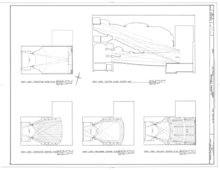
A movie theater, cinema, or cinema hall, also known as a movie house, picture house, picture theater or simply theater, is a business that contains auditoria for viewing films for public entertainment. Most are commercial operations catering to the general public, who attend by purchasing tickets.

An aisle is a linear space for walking with rows of non-walking spaces on both sides. Aisles with seating on both sides can be seen in airplanes, in buildings such as churches, cathedrals, synagogues, meeting halls, parliaments, courtrooms, theatres, and in long passenger vehicles. An aisle floor may be level or, as in theatres, sloping upward from a stage.

The Oregon Shakespeare Festival (OSF) is a regional repertory theatre in Ashland, Oregon, United States, founded in 1935 by Angus L. Bowmer. The Festival now offers matinee and evening performances of a wide range of classic and contemporary plays not limited to Shakespeare. During the Festival, between five and eleven plays are offered in daily rotation six days a week in its three theatres. It welcomed its millionth visitor in 1971, its 10-millionth in 2001, and its 20-millionth visitor in 2015.

An auditorium is a room built to enable an audience to hear and watch performances. For movie theatres, the number of auditoria is expressed as the number of screens. Auditoria can be found in entertainment venues, community halls, and theaters, and may be used for rehearsal, presentation, performing arts productions, or as a learning space.

Tannadice Park, usually referred to as Tannadice, is a football stadium in Dundee, Scotland. It is the home ground of Dundee United F.C., who have played at Tannadice since the club was founded as Dundee Hibernian in 1909. The stadium has been all-seated since 1994 and has a capacity of 14,223. It is located only 200 yards from Dundee F.C.'s stadium, Dens Park; the two are the closest senior football grounds in the UK.

The Theatre of Dionysus is an ancient Greek theatre in Athens. It is built on the south slope of the Acropolis hill, originally part of the sanctuary of Dionysus Eleuthereus. The first orchestra terrace was constructed on the site around the mid- to late-sixth century BC, where it hosted the City Dionysia. The theatre reached its fullest extent in the fourth century BC under the epistates of Lycurgus when it would have had a capacity of up to 25,000, and was in continuous use down to the Roman period. The theatre then fell into decay in the Byzantine era and was not identified, excavated and restored to its current condition until the nineteenth century.
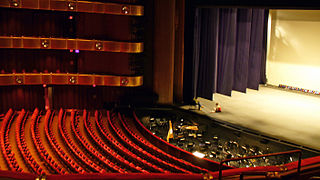
An orchestra pit is an area in a theater in which musicians perform. The orchestra plays out of general sight in the pit, rather than on the stage as for a concert, when providing music for forms of theatre that require it or when incidental music is required. The conductor typically stands at the front of the orchestra pit facing the stage.

In theatre and performing arts, the stage is a designated space for the performance of productions. The stage serves as a space for actors or performers and a focal point for the audience. As an architectural feature, the stage may consist of a platform or series of platforms. In some cases, these may be temporary or adjustable but in theaters and other buildings devoted to such productions, the stage is often a permanent feature.

A theater, or playhouse, is a structure where theatrical works, performing arts, and musical concerts are presented. The theater building serves to define the performance and audience spaces. The facility usually is organized to provide support areas for performers, the technical crew and the audience members, as well as the stage where the performance takes place.
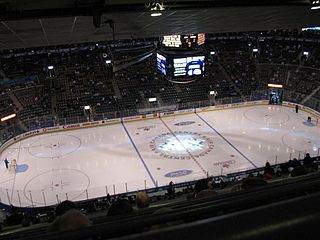
Stadium seating or theater seating is a characteristic seating arrangement that is most commonly associated with performing-arts venues, and derives its name from stadiums, which typically use this arrangement.

A rake or raked stage is a theatre stage that slopes upwards, away from the audience. Such a design was typical of English theatre in the Middle Ages and early Modern era, and improves the view and sound for spectators. It also helps with the illusion of perspective: when features of the scenery are made to align with a notional vanishing point beyond the rear of the stage, the rake supports the illusion. These elements of scenery are termed raking pieces.

Theater drapes and stage curtains are large pieces of cloth that are designed to mask backstage areas of a theater from spectators. They are designed for a variety of specific purposes, moving in different ways and constructed from various fabrics. Many are made from black or other darkly colored, light-absorbing material. Theater drapes represent a portion of any production's soft goods, a category comprising any non-wardrobe, cloth-based element of the stage or scenery. Theater curtains are often pocketed at the bottom to hold weighty chain or to accept pipes to remove their fullness and stretch them tight.
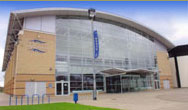
Grimsby Auditorium is a theatre situated on Cromwell Road, in Grimsby, North East Lincolnshire. With a seated audience capacity of 1,200 the Grimsby Auditorium is the largest professional theatre in Lincolnshire, and one of the larger theatres in the East of England. Built in 1995, it is today managed by Lincs Inspire on behalf of its owners North East Lincolnshire Council.

The Joan W. and Irving B. Harris Theater for Music and Dance is a 1,499-seat theater for the performing arts located along the northern edge of Millennium Park on Randolph Street in the Loop community area of Chicago in Cook County, Illinois, US. The theater, which is largely underground due to Grant Park-related height restrictions, was named for its primary benefactors, Joan and Irving Harris. It serves as the park's indoor performing venue, a complement to Jay Pritzker Pavilion, which hosts the park's outdoor performances.
There are different types of theatres, but they all have three major parts in common. Theatres are divided into two main sections, the house and the stage; there is also a backstage area in many theatres. The house is the seating area for guests watching a performance and the stage is where the actual performance is given. The backstage area is usually restricted to people who are producing or in the performance.
The American Society of Theatre Consultants (ASTC) is a professional organization whose main goal is to apprise owners, contractors and/or architects of the services that a theatre consultant can perform, whether it be for a new or renovated facility.
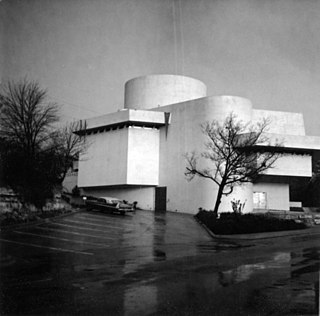
The Kalita Humphreys Theater is a historic theater in Dallas, Texas (USA). It is the only theater by architect Frank Lloyd Wright and one of the last completed buildings he designed. It was built in 1959 for Dallas Theater Center who still produces original productions on the revolving stage. Other Dallas theater groups also use the Kalita Humphreys Theater throughout the year, including Uptown Players and Second Thought Theater.
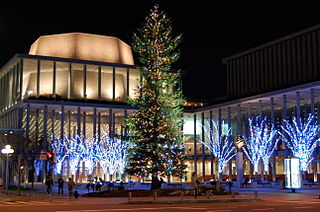
The Hyogo Performing Arts Center (HPAC) is a performing arts center in the city of Nishinomiya, Hyōgo Prefecture, Japan, next to Nishinomiya-Kitaguchi Station operated by Hankyu Corporation. The Center was opened in 2005 to mark the ten-year anniversary of the Great Hanshin earthquake which largely devastated Nishinomiya and the surrounding cities.

The Sylvan Theater Historic District, also known as Greenwood Park Outdoor Theater, is located in Des Moines, Iowa, United States. It has been listed on the National Register of Historic Places since 1995.
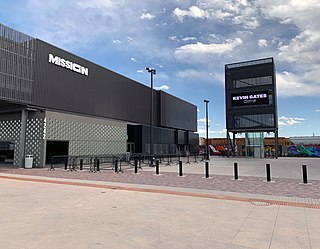
The Mission Ballroom is a concert venue located in the RiNo neighborhood of Denver, Colorado. The building opened in August 2019 with a capacity of nearly 4,000 patrons. Operated by AEG Presents Rocky Mountain, the venue is viewed as a competitor to the Live Nation operated Fillmore Auditorium.
